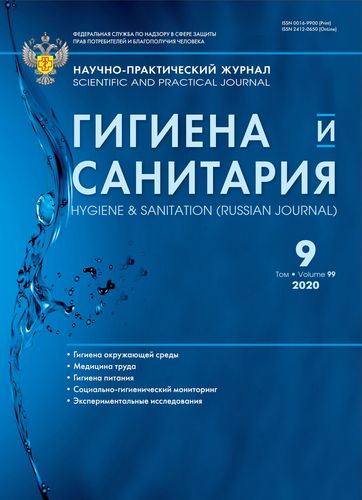Toxicokinetics of aluminum in rats
- Authors: Usmanova E.N.1, Fazlyeva A.S.1, Karimov D.O.1, Ziatdinova M.M.1, Daukaev R.A.1, Khusnutdinova N.Y.1, Kurilov M.V.1
-
Affiliations:
- Ufa Research Institute of Occupational Health and Human Ecology
- Issue: Vol 99, No 9 (2020)
- Pages: 1007-1010
- Section: EXPERIMENTAL INVESTIGATIONS
- Published: 20.10.2020
- URL: https://ruspoj.com/0016-9900/article/view/640271
- DOI: https://doi.org/10.47470/0016-9900-2020-99-9-1007-1010
- ID: 640271
Cite item
Full Text
Abstract
Introduction. Aluminum is one of the most common elements in nature that is potentially toxic to humans. Aluminum compounds are widely used in the aviation and food industries, metallurgy, electrical engineering, and medicine. Aluminum is capable of accumulating in the human body, which creates a risk for the development of severe diseases.
Material and methods. Acute intoxication of aluminum hydroxide was simulated on white outbred rats weighing 170-220 g, divided into 8 groups (intact and 7 experimental). By the atomic absorption method, the concentrations of aluminum, calcium, magnesium, and iron in the organs of laboratory animals (kidneys, liver, blood, and brain) were determined 1, 2, 4, 6, 24, 48, and 96 hours after intoxication.
Results. The accumulation of aluminum was observed to a greater extent in the liver, kidneys, blood, to a lesser extent in the brain. Aluminum affects the homeostasis of essential elements, for example, in the experiment, a decrease in the content of calcium and magnesium in the organs of laboratory animals is observed. The seed level does not have a strong effect on the level of iron. At the end of the experiment, the concentration of aluminum in the liver, blood, and brain of rats remains higher than in the control group.
Conclusion. Aluminum is capable of accumulating in vital organs and affecting the homeostasis of the essential elements of the body. The circulation of aluminum in the biological media of a living organism, like many processes, is undulating, and it can accumulate and diffuse for a long time in various organs of experimental animals.
Keywords
About the authors
Elza N. Usmanova
Ufa Research Institute of Occupational Health and Human Ecology
Author for correspondence.
Email: elza90@inbox.ru
ORCID iD: 0000-0002-5455-6472
MD, junior researcher of the Chemical analysis Department of Ufa Research Institute of Occupational Health and Human Ecology, Ufa, 450106, Russia Federation.
e-mail: elza90@inbox.ru
Russian FederationAnna S. Fazlyeva
Ufa Research Institute of Occupational Health and Human Ecology
Email: noemail@neicon.ru
ORCID iD: 0000-0002-0037-6791
Russian Federation
Denis O. Karimov
Ufa Research Institute of Occupational Health and Human Ecology
Email: noemail@neicon.ru
ORCID iD: 0000-0003-0039-6757
Russian Federation
Munira M. Ziatdinova
Ufa Research Institute of Occupational Health and Human Ecology
Email: noemail@neicon.ru
ORCID iD: 0000-0002-1848-7959
Russian Federation
Rustem A. Daukaev
Ufa Research Institute of Occupational Health and Human Ecology
Email: noemail@neicon.ru
ORCID iD: 0000-0002-0421-4802
Russian Federation
Nadezhda Yu. Khusnutdinova
Ufa Research Institute of Occupational Health and Human Ecology
Email: noemail@neicon.ru
ORCID iD: 0000-0001-5596-8180
Russian Federation
Mihail V. Kurilov
Ufa Research Institute of Occupational Health and Human Ecology
Email: noemail@neicon.ru
ORCID iD: 0000-0002-2818-1558
Russian Federation
References
- Skal’nyy A.V., Rudakov I.A. Bioelements in Medicine [Bioelementy v meditsine]. Moscow: MIR; 2004. (in Russian)
- Boegman R.J., Bates L.A. Neurotoxicity of aluminium. Can. J. Physiol. Pharmacol. 1984; 62(8): 1010–14. https://doi.org/10.1139/y84-170
- Fekete V., Deconinck E., Bolle F., Van Loco J. Modelling aluminum leaching into food from different foodware materials with multi-level factorial design of experiments. Food Addit. Contam. Part. A Chem. Anal. Control Expo. Risk Assess. 2012; 29(8): 1322–33. https://doi.org/10.1080/19440049.2012.688068
- Avtsyn A.P., Rudakov I.A. Human Trace Elements [Mikroelementozy cheloveka]. Moscow: Meditsina; 1991. (in Russian)
- Stahl T., Falk S., Rohrbeck A., Georgii S., Herzog C., Wiegand A., et al. Migration of aluminum from food contact materials to food — a health risk for consumers? Part I of III: exposure to aluminum, release of aluminum, tolerable weekly intake (TWI), toxicological effects of aluminum, study design, and methods. Environ. Sci. Eur. 2017; 29(1): 19. https://doi.org/10.1186/s12302-017-0116-y
- Khotimchenko S.A., Bessonov V.V., Bagryantseva O.V., Gmoshinskiy I.V. Safety of food products: new problems and ways of solution. Meditsina truda i ekologiya cheloveka. 2015; (4): 7–14. (in Russian)
- Bagryantseva O.V., Shatrov G.N., Khotimchenko S.A., Bessonov V.V., Arnautov O.V. Aluminium: food-related health risk assessment of the consumers. Analiz riska zdorov’yu. 2012; (1): 59–68. https://doi.org/10.21668/health.risk/2016.1.07 (in Russian)
- Martinez C.S., Alterman C.D., Peçanha F.M., Vassallo D.V., Mello-Carpes P.B., Miguel M., et al. Aluminum exposure at human dietary levels for 60 days reaches a threshold sufficient to promote memory impairment in rats. Neurotox. Res. 2017; 31(1): 20-30. https://doi.org/10.1007/s12640-016-9656-y
- Exley C. The coordination chemistry of aluminium in neurodegenerative disease. Coord. Chem. Rev. 2012; 256(19-20): 2142–6.
- Konishi Y., Yagyu K., Kinebuchi H., Saito N., Yamaguchi T., Ohtsuki Y. Chronic effect of aluminium ingestion on bone in calcium-deficient rats. Pharmacol. Toxicol. 1996; 78(6): 429–34. https://doi.org/10.1111/j.1600-0773.1996.tb00231.x
- Trapp G.A. Plasma aluminum is bound to transferrin. Life Sci. 1983; 33(4): 311–6. https://doi.org/10.1016/s0024-3205(83)80002-2
- Yokel R.A. The toxicology of aluminum in the brain: a review. Neurotoxicology. 2000; 21(5): 813–28.
- Rebrova O.Yu. Statistical Analysis of Medical Data. Application of Software Package STATISTICA [Statisticheskiy analiz meditsinskikh dannykh. Primenenie paketa prikladnykh programm STATISTICA]. Moscow: MediaSfera; 2006. (in Russian)
- Kurets N.I. A role of chemical elements disbalance in children’s chronic pathology formation. Sanitarnyy vrach. 2009; (7): 17–28. (in Russian)
- Prousek J. Fenton chemistry in biology and medicine. Pure Appl. Chem. 2007; 79(12): 2325–38.
- Kim Y., Olivi L., Cheong J.H., Maertens A., Bressler J.P. Aluminum stimulates uptake of non-transferrin bound iron and transferrin bound iron in human glial cells. Toxicol. Appl. Pharmacol. 2007; 220(3): 349–56. https://doi.org/10.1016/j.taap.2007.02.001
- Mousavi S., Mojtahedzadeh M., Abdollahi M. Management of hyperoxia-induced lung injury; a systematic review. Int. J. Pharmacol. 2010; 6(4): 397–408.
- Gres’ N.A., Guzik E.O. Hygienic aspects of aluminum overdose forming among humans. Mikroelementy v meditsine. 2015; 16(2): 28–36. (in Russian)
- Barbagallo M., Dominguez L.J. Type 2 diabetes mellitus and Alzheimer’s disease. World J. Diabetes. 2014; 5(6): 889–93. https://doi.org/10.4239/wjd.v5.i6.889
- Drobyshev E.J., Solovyev N.D., Gorokhovskiy B.M., Kashuro V.A. Accumulation patterns of sub-chronic aluminum toxicity model after gastrointestinal administration in rats. Biol. Trace Elem. Res. 2018; 185(2): 384–94.
Supplementary files









